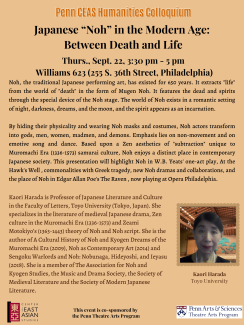Event

3:30pm - 5pm
Space is limited. Advance registration is required.
Noh, the traditional Japanese performing art, has existed for 650 years. It extracts "life" from the world of "death" in the form of Mugen Noh. It features the dead and spirits through the special device of the Noh stage. The world of Noh exists in a romantic setting of night, darkness, dreams, and the moon, and the spirit appears as an incarnation.
By hiding their physicality and wearing Noh masks and costumes, Noh actors transform into gods, men, women, madmen, and demons. Emphasis lies on non-movement and on emotive song and dance. Based upon a Zen aesthetics of "subtraction" unique to Muromachi Era (1336-1573) samurai culture, Noh enjoys a distinct place in contemporary Japanese society. This presentation will highlight Noh in W.B. Yeats' one-act play, At the Hawk's Well , commonalities with Greek tragedy, new Noh dramas and collaborations, and the place of Noh in Edgar Allan Poe's The Raven , now playing at Opera Philadelphia.
Speaker:
Kaori Harada is Professor of Japanese Literature and Culture in the Faculty of Letters, Toyo University (Tokyo, Japan). She specializes in the literature of medieval Japanese drama, Zen culture in the Muromachi Era (1336-1573) and Zeami Motokiyo’s (1363-1443) theory of Noh and Noh script. She is the author of A Cultural History of Noh and Kyogen Dreams of the Muromachi Era (2009), Noh as Contemporary Art (2014) and Sengoku Warlords and Noh: Nobunaga, Hideyoshi, and Ieyasu (2018). She is a member of The Association for Noh and Kyogen Studies, the Music and Drama Society, the Society of Medieval Literature and the Society of Modern Japanese Literature.
Presented by the Center for East Asian Studies, co-sponsored by the Theatre Arts Program

